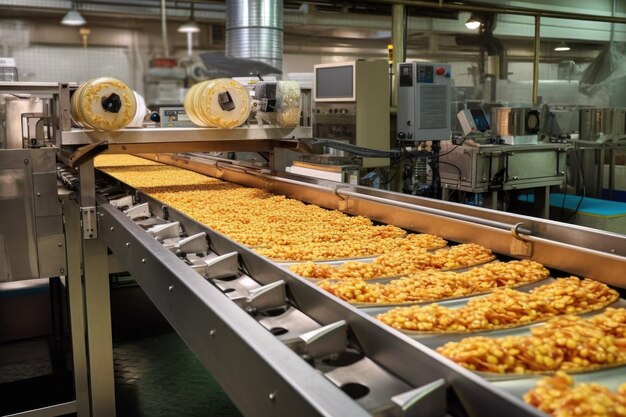Role of Sensors in the Food Processing Plant
The food processing industry is essential as it ensures the safety and quality of the food we consume daily. From field to table, this sector transforms raw materials into safe, nutritious, and appetizing meals. The entire process involves numerous steps, including preparation, preservation, packaging, and distribution, all of which are crucial for maintaining hygiene and ensuring the food's longevity.

### The Role of Sensors in Modern Food Processing
In today's advanced food processing plants, sensors have become indispensable tools that help maintain the integrity of food products. These tiny yet powerful devices play a variety of roles:
- **Precision Monitoring:** Sensors track important variables such as temperature, moisture, and pressure, ensuring that every stage of production adheres to strict standards.
- **Quality Control:** By detecting inconsistencies, sensors guarantee uniformity in product quality, minimizing errors and preventing substandard items from reaching consumers.
- **Safety Assurance:** Real-time detection of contaminants or irregularities allows for quick responses, safeguarding both producers and customers from potential health risks.
- **Efficiency Improvement:** By optimizing resource use, sensors reduce waste and energy consumption, leading to cost savings and better operational performance.
- **Regulatory Compliance:** Sensors help facilities comply with stringent food safety regulations, protecting consumers and avoiding legal issues for businesses.
### The Various Stages Involved in Food Processing
Each step in food processing is meticulously planned to convert raw materials into consumable goods safely and effectively. Here are the main stages:
- **Preparation:** Cleaning, peeling, cutting, and sorting raw materials prepare them for further processing. This stage focuses on removing impurities and achieving uniformity.
- **Processing:** Techniques like grinding, cooking, and mixing transform raw ingredients into edible forms. Heat treatments, such as pasteurization, eliminate harmful bacteria.
- **Preservation:** Methods like canning, freezing, drying, or refrigeration extend shelf life by slowing down spoilage.
- **Packaging:** Proper packaging protects food from external factors while maintaining freshness. Labels provide necessary information and branding details.
- **Quality Control:** Regular checks ensure products meet desired standards regarding taste, texture, appearance, and safety.
- **Distribution:** Efficient logistics ensure timely delivery to markets and consumers.
- **Consumption:** Consumers enjoy safe and high-quality food.
- **Waste Management:** Sustainable practices manage waste generated during processing.
### Types of Sensors Used in Food Processing
A wide range of sensors support different aspects of food processing:
- **Temperature Sensors:** Devices like thermocouples and RTDs monitor temperatures during cooking, refrigeration, etc., preventing microbial growth.
- **Pressure Transducers:** Monitor fluid pressure in machinery, enhancing safety and efficiency.
- **Moisture Sensors:** Measure moisture levels in food items like cereals or bakery goods, aiding in quality assurance.
- **Flow Sensors:** Control liquid flow rates during mixing, filling, etc., ensuring accurate recipes.
- **pH Sensors:** Track acidity levels, influencing flavor and shelf life.
- **Gas Sensors:** Detect gases within packaging, helping preserve freshness.
- **Metal Detection Sensors:** Identify metallic contaminants, improving food safety.
- **Optical Sensors:** Spot foreign particles or flaws in products.
- **Ultrasonic Sensors:** Measure levels in tanks, aiding inventory management.
- **Infrared Sensors:** Analyze food composition and moisture content.
### Conclusion
Sensors are the backbone of modern food processing facilities, ensuring that every product complies with safety and quality benchmarks. Whether they’re tracking temperature fluctuations or detecting minute impurities, these sensors work tirelessly to uphold trust between manufacturers and consumers.
For more insights into temperature measurement solutions like RTDs and thermocouples, reach out to The Transmitter Shop at +1-888-964-8837 or [email protected]. Our team can guide you through selecting the right sensors tailored to your needs.
#### Related Posts
- What is an RTD Sensor and How Does It Function?
- Understanding Thermocouples: Principles and Applications
- A Step-by-Step Guide to Installing Thermowells
- Why Platinum is Preferred in RTD Sensors
- Selecting the Best Exhaust Gas Temperature Sensor for Engines
- The Critical Role of Sensors in Food Processing Facilities
This article highlights just how integral sensors are to the food industry. As technology evolves, so too will the capabilities of these sensors, further enhancing food safety and efficiency worldwide.
Polymer Synthetic Material Roller
Polymer Synthetic Material Roller,Calender Roller,Carbon Fiber Roller Shaft,Flattening Roller
Jiangyin Mingda Rubber Roller Co,Ltd , https://www.mingdaroller.com